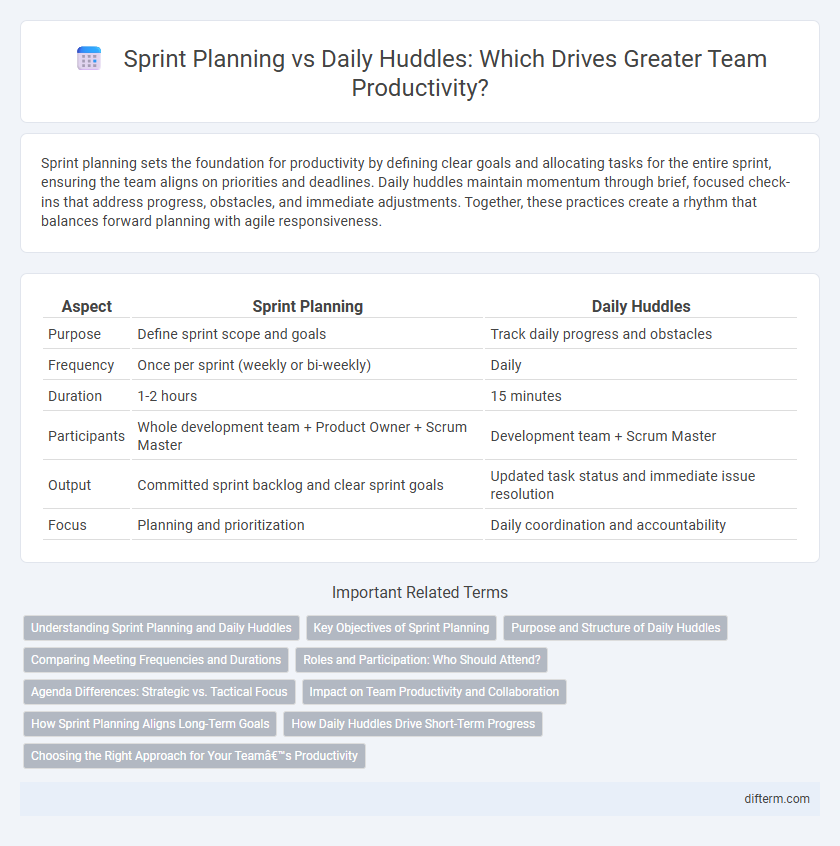Sprint planning sets the foundation for productivity by defining clear goals and allocating tasks for the entire sprint, ensuring the team aligns on priorities and deadlines. Daily huddles maintain momentum through brief, focused check-ins that address progress, obstacles, and immediate adjustments. Together, these practices create a rhythm that balances forward planning with agile responsiveness.
Table of Comparison
| Aspect | Sprint Planning | Daily Huddles |
|---|---|---|
| Purpose | Define sprint scope and goals | Track daily progress and obstacles |
| Frequency | Once per sprint (weekly or bi-weekly) | Daily |
| Duration | 1-2 hours | 15 minutes |
| Participants | Whole development team + Product Owner + Scrum Master | Development team + Scrum Master |
| Output | Committed sprint backlog and clear sprint goals | Updated task status and immediate issue resolution |
| Focus | Planning and prioritization | Daily coordination and accountability |
Understanding Sprint Planning and Daily Huddles
Sprint planning establishes clear goals by defining the work to be completed in the upcoming sprint, enabling teams to allocate resources efficiently and set realistic deadlines. Daily huddles, or stand-up meetings, facilitate continuous progress tracking, immediate issue resolution, and team alignment on daily objectives. Combining sprint planning with daily huddles enhances overall productivity by balancing long-term planning with short-term adaptability.
Key Objectives of Sprint Planning
Sprint planning centers on defining clear, achievable objectives for the entire sprint, ensuring alignment among team members on deliverables and timelines. It establishes the sprint backlog by prioritizing user stories and tasks that directly contribute to sprint goals. This structured approach enhances focus, resource allocation, and risk management throughout the sprint cycle.
Purpose and Structure of Daily Huddles
Daily huddles serve to align team members quickly on immediate priorities, fostering transparency and swift identification of blockers with a strict time-boxed format typically lasting 15 minutes. Unlike sprint planning, which sets the roadmap for the upcoming sprint with detailed task assignments and goals, daily huddles focus on real-time progress updates and synchronization. These focused meetings enhance team agility by ensuring continuous communication and prompt adjustments to stay on track with sprint objectives.
Comparing Meeting Frequencies and Durations
Sprint planning meetings typically occur once per sprint, lasting between one to four hours depending on team size and sprint length, allowing for comprehensive backlog refinement and task prioritization. Daily huddles are brief, usually 15 minutes or less, held every workday to synchronize team members, address immediate obstacles, and ensure progress alignment. The contrast in frequency and duration highlights sprint planning's role in strategic preparation versus daily huddles' function in tactical, real-time coordination.
Roles and Participation: Who Should Attend?
Sprint planning requires the active participation of the entire Scrum team, including the Product Owner, Scrum Master, and development team members to collaboratively define the sprint goal and backlog. Daily huddles, or daily stand-ups, involve primarily the development team and Scrum Master, focusing on status updates and immediate obstacle identification. Stakeholders typically attend sprint planning for clarification but usually do not participate in daily huddles to maintain efficiency and team focus.
Agenda Differences: Strategic vs. Tactical Focus
Sprint planning centers on establishing a strategic agenda by defining long-term goals, prioritizing backlog items, and setting clear deliverables for the entire sprint cycle. Daily huddles adopt a tactical approach, concentrating on immediate task updates, quick obstacle identification, and real-time coordination among team members. This distinction ensures that sprint planning drives overarching project alignment, while daily huddles optimize day-to-day team productivity.
Impact on Team Productivity and Collaboration
Sprint planning sets clear goals and timelines, enhancing team productivity by aligning tasks with project objectives. Daily huddles foster collaboration through rapid communication, enabling quick issue resolution and continuous progress updates. Together, these practices boost efficiency by synchronizing efforts and maintaining team focus.
How Sprint Planning Aligns Long-Term Goals
Sprint planning establishes a clear roadmap by defining specific deliverables and timelines that align with long-term strategic objectives, ensuring teams stay focused on overarching goals. It allocates resources and prioritizes tasks to maximize productivity over the sprint cycle, fostering consistent progress toward project milestones. Unlike daily huddles, which address immediate challenges and short-term adjustments, sprint planning anchors team efforts to a cohesive vision that drives sustained success.
How Daily Huddles Drive Short-Term Progress
Daily huddles drive short-term progress by fostering real-time communication and rapid issue resolution, ensuring teams stay aligned on immediate goals. These brief, focused meetings enhance accountability and enable quick adjustments to tasks, accelerating productivity within sprint cycles. By maintaining continuous momentum, daily huddles complement sprint planning, which maps out long-term objectives and deliverables.
Choosing the Right Approach for Your Team’s Productivity
Sprint planning establishes clear goals and deliverables for a defined period, aligning team efforts towards strategic objectives and maximizing output through structured timelines. Daily huddles promote continuous communication, quick issue resolution, and adaptive workflow adjustments to maintain momentum and prevent bottlenecks. Selecting between sprint planning and daily huddles depends on your team's size, project complexity, and the need for flexibility versus long-term focus to enhance overall productivity.
sprint planning vs daily huddles Infographic

 difterm.com
difterm.com